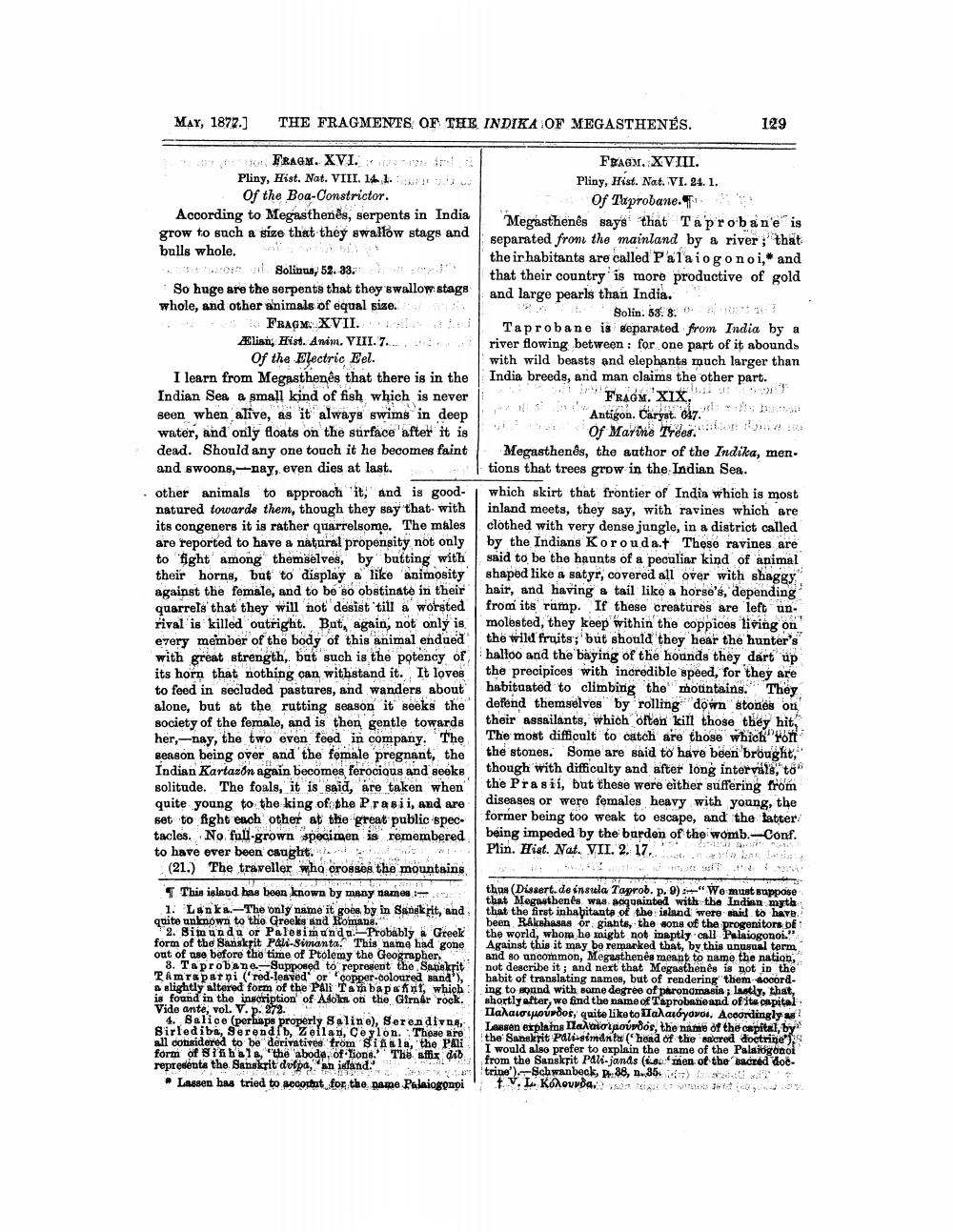________________
MAY, 1877.]
THE FRAGMENTS OF THE INDIKA OF MEGASTHENES.
129
FRAGM. XVI.
FBGM. XVIII. Pliny, Hist. Nat. VIII. 14. 1.
Pliny, Hist. Nat. VI. 84. 1. Of the Boa-Constrictor.
Of Taprobane. According to Megasthenès, serpents in India
Megasthenes says that Taproban'e is grow to such a size that they swallow stags and
separated from the mainland by a river ; that bulls whole.
their habitants are called Palaiogonoi, and O" u Solinua, 52. 33.
that their country is more productive of gold So huge are the serpents that they swallow-stags
and large pearls than India. whole, and other animals of equal size.
Solin. 58. 8. FRAGM. XVII.
Taprobane is separated from India by a Ælisn, Hist. Anim. VIII.7...
river flowing between : for one part of it abounds Of the Electric Eel.
with wild beasts and elephants much larger than I learn from Megasthenes that there is in the India breeds, and man claims the other part. Indian Sea a small kind of fish which is never
Fridy'xix
! seen when alive, as it always swims in deep
Antigon Caryst oz. water, and only floats on the stirface after it is
Of Marine Treer. dead. Should any one touch it he becomes faint Megasthenès, the author of the Indika, men. and swoons--nay, even dies at last.
t ions that trees grow in the Indian Sea. other animals to approach it, and is good- which skirt that frontier of India which is most natured towards them, though they say that with inland meets, they say, with ravines which are its congeners it is rather quarrelsome. The males clothed with very dense jungle, in a district called are reported to have a natural propensity not only by the Indians Korouda. These ravines are to fight among themselves, by butting with said to be the haunts of a peculiar kind of animal their horns, but to display a like animosity | shaped like a satyr, covered all over with shaggy against the female, and to be so obstinate in their hair, and having a tail like a horso's, depending quarrels that they will not desist till a worsted from its ramp. If these creatures are left un. rival is killed outright. But, again, not only is molested, they keep within the coppices living on every member of the body of this animal endued the wild fruits'; 'but should they hear the hunter's with great strength, but such is the potency of halloo and the baying of the hounds they dart up its horn that nothing can withstand it. It loves the precipices with incredible speed, for they are to feed in secluded pastures, and wanders about habituated to climbing the mountains. They alone, but at the rutting season it seeks the defend themselves by rolling down tone on society of the female, and is then gentle towards
their assailants, which often kill those they hit, her,-nay, the two oven food in company. The The most difficult to catch are those whickor Renson being over and the female pregnant, the the stones. Some are said to have been brought, Indian Kartazón again becomes ferocious and seeks
though with difficulty and after long intervils, to" solitude. The foals, it is said, are taken when
the Prasii, but these were either suffering from quite young to the king of the Prasii, and are diseases or were females heavy with young, the set to fight each other at the great public spec
former being too weak to escape, and the latter tacles. No fall-grown specimen is remembered
being impeded by the burden of the womb.-Conf. to have ever been caught.
.. Fm. Plin. Hist. Nat. VII. 2. 17.
1 . A VIL. 2. 1.. . (21.) The traveller who crosses the mountains This island has been known by maay naman 2
thun (Dissert. de instela Tagrob. p. 9). "Wo must suppose
that Megastbenés was acquainted with the Indian mytla 1. Lanka. The only name it goes by in Sanskrit, and that the first inhabitants of the island were said to have quite unknown to the Greeks and Romana.
been Rakshasas or giants, the sons of the progenitors of 2. Bim unda or Palesimundo. Probably a Greek the world, whom he might not inaptly call Palaiogonoi." form of the Sanskrit Pali-Simanta. This name had gone Against this it may be remarked that, by this unusual term out of use before the time of Ptolemy the Geographer, and so uncommon, Megasthenes meant to name the nation,
8. Taprobane-Supposed to represent the Sanskrit not describe it ; and next that Megasthenés is not in the P&mrapat ni red-leaved or copper-coloured sand'), habit of translating names, but of rendering them sooorda slightly altered form of the PAli Tai bapaknt, which : ing to sound with some degree of parondmasis lastly, that, is found in the inscription of Adoks on the Girnar rock. shortly after, we find the name of Taprobateand of itu capital Vide ante, vol. V. p. 272.
Ilalawipoúrdos, quite like to talatoyovos. Acoordingly w 4. Blige (perhaps properly Salino), Seren di
Taman atnlama llamolaourdos. the name of the capital, by" Birledibi. Serondlb, Zollani, Coylon. These are the Sanskrit Palindi idea to be derivatives from Sisla, the Pali
(hend of the Ancred doctrines
I wonld also prefer to explain the name of the Palamono Ca s h
the aboda, oftions. The uffix dib from the Sanskrit Pan-sands (lamen of the bacred doc. representa the Sanskrit dupa, an and"
trine').-Schwanbeck, 88, n.35 ) Lassen bas tried to accortot for the name Palaiogonpi l . Kouvoa. A
tion




